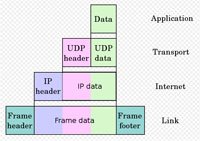Difference Between TCP and HTTP

Transmission Control Protocol (also known as TCP) is a core protocol of the Internet Protocol Suite. It operates at a higher level than its compatriot, Internet Protocol (also known as IP). The two main concerns of TCP are the two end systems –a web browser and a web server, for example. TCP provides the delivery of a stream of bytes from a program from one computer to another computer. TCP is also in charge of controlling size, flow control, the rate of data exchange, and network traffic congestion.
Hypertext Transfer Protocol (also known as HTTP) is an Application Layer protocol –meaning it is a protocol that categorises other protocols and methods in the architectural models of computer networking. It is used for those information systems that are distributed, collaborative, and hypermedia. It is a request/response standard that is commonly found in client server computing –in which the web browsers or spiders serve as the clients and an application running on the computer and hosting the web site serves as the actual server.
TCP provides communication services at an intermediate level between an application program and the IP. What this means is that when an application program wants to send a large piece of data across the internet using the IP, instead of breaking the data into sizes that will fit the IP and using a series of requests from the IP, the software is capable of issuing a single request to TCP and let this protocol handle the details of the IP transfer. TCP detects problems that arise in the IP, requests retransmission of the packets that were lost, rearranges the order of the packets (so that they are put back into their proper order), and helps to minimise network congestion (in order to reduce the occurrence of other problems down the line). Once all this has been done and the proper copy of the data has been compiled, the packet is passed along to application program.
In HTTP there is such a phenomenon as a session. An HTTP session is, in fact, a sequence of request/response transactions that occur on the network. The client puts forth the request and establishes a TCP connection to a particular port on a specific host. The HTTP server ‘listens in’ on that particular port and awaits a request message from the client. Once this request is received, the server sends the line back to the client with its own message –which is comprised of the requested resource, an error message, or any other piece of information.
Summary:
1. TCP is a core operates a relatively high level; HTTP is an Application Layer protocol that is a request/response standard found in client server computing.
2. TCP provides communication services at an intermediate level between an application program and the IP; in HTTP there are a series of sessions in which the client sends a request and the server sends a reply message back to the client including the request, an error message, or another piece of information.
- Difference Between VC++ and C++ - April 20, 2010
- Difference Between Aluminum and Carbon Arrows - April 15, 2010
- Difference Between SFTP and SCP - April 15, 2010

Clear as mud. Thanks.
Yes clear as mud
you are in point of fact a excellent webmaster. The site loading
velocity is amazing. It kind of feels that you are
doing any distinctive trick. Furthermore, The contents are masterwork.
you’ve done a great job on this subject!